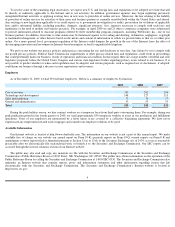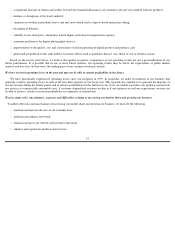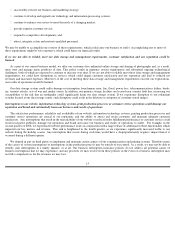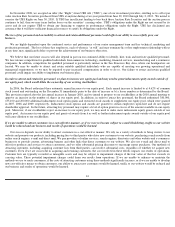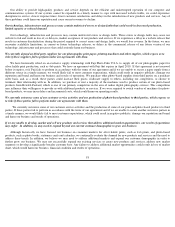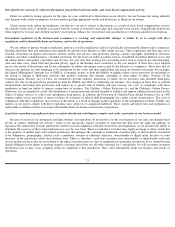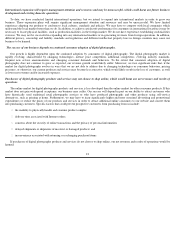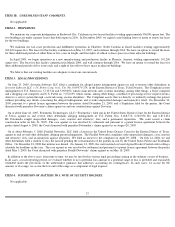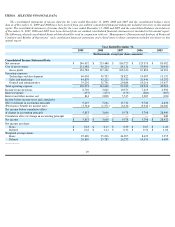Shutterfly 2010 Annual Report Download - page 21
Download and view the complete annual report
Please find page 21 of the 2010 Shutterfly annual report below. You can navigate through the pages in the report by either clicking on the pages listed below, or by using the keyword search tool below to find specific information within the annual report.
We may undertake acquisitions to expand our business, which may pose risks to our business and dilute the ownership of our existing
stockholders.
A key component of our business strategy includes strengthening our competitive position and refining the customer experience on our
website through internal development. However, from time to time, we may selectively pursue acquisitions of businesses, such as our 2008
acquisition of Nexo and our September 2009 acquisition of TinyPictures. Integrating any newly acquired businesses, technologies or services is
likely to be expensive and time consuming. To finance any acquisition, it may be necessary for us to raise additional funds through public or
private financings. Additional funds may not be available on terms that are favorable to us, and, in the case of equity financings, would result in
dilution to our stockholders. Also, the value of our stock may be insufficient to attract acquisition candidates. If we do complete any
acquisitions, we may be unable to operate the acquired businesses profitably or otherwise implement our strategy successfully. If we are unable
to integrate any newly acquired entities, technologies or services effectively, our business and results of operations will suffer. The time and
expense associated with finding suitable and compatible businesses, technologies or services could also disrupt our ongoing business and divert
our management’s attention. Future acquisitions by us could also result in large and immediate write-
offs or assumptions of debt and contingent
liabilities, any of which could substantially harm our business and results of operations.
Our net revenues and results of operations are affected by the level of vacation and other travel by our customers, and any declines or
disruptions in the travel industry could harm our business.
Because vacation and other travel is one of the primary occasions in which our customers utilize their digital cameras, our net revenues and
results of operations are affected by the level of vacation and other travel by our customers. Accordingly, downturns or weaknesses in the travel
industry could harm our business. Travel expenditures are sensitive to business and personal discretionary spending levels and tend to decline
during general economic slowdowns such as those currently being experienced in the U.S. and worldwide. Events or weakness that could
negatively affect the travel industry include price escalation in the airline industry or other travel-
related industries, airline or other travel related
strikes, safety concerns, including terrorist activities, pandemic disease (including the influenza virus), inclement weather and airline
bankruptcies or liquidations. In addition, high gasoline prices may lead to reduced travel in the United States. Any decrease in vacation or travel
could harm our net revenues and results of operations.
Failure to adequately protect our intellectual property could substantially harm our business and results of operations.
We rely on a combination of patent, trademark, trade secret and copyright law and contractual restrictions to protect our intellectual
property. These protective measures afford only limited protection. Despite our efforts to protect our proprietary rights, unauthorized parties may
attempt to copy aspects of our website features and functionalities or to obtain and use information that we consider proprietary, such as the
technology used to operate our website, our production operations and our trademarks.
As of December 31, 2009, we had 35 patents issued and more than 20 patent applications pending in the United States. We intend to pursue
corresponding patent coverage in other countries to the extent we believe such coverage is appropriate and cost efficient. We cannot ensure that
any of our pending applications will be granted. In addition, third parties have in the past and could in the future bring infringement, invalidity,
co-
inventorship or similar claims with respect to any of our currently issued patents or any patents that may be issued to us in the future. Any
such claims, whether or not successful, could be extremely costly to defend, divert management’
s time and attention, damage our reputation and
brand and substantially harm our business and results of operations.
Our primary brand is “Shutterfly.”
We hold registrations for the Shutterfly and other trademarks in our major markets of the United States
and Canada, as well as in the European Community, Mexico, Japan, Australia and New Zealand. Our competitors may adopt names similar to
ours, thereby impeding our ability to build brand identity and possibly leading to customer confusion. In addition, there could be potential trade
name or trademark infringement claims brought by owners of marks that are similar to Shutterfly or one of our other marks. The Shutterfly brand
is a critical component of our marketing programs. If we lose the ability to use the Shutterfly service mark in any particular market, we could be
forced to either incur significant additional marketing expenses within that market, or elect not to sell products in that market. Any claims or
customer confusion related to our marks could damage our reputation and brand and substantially harm our business and results of operations.
19


